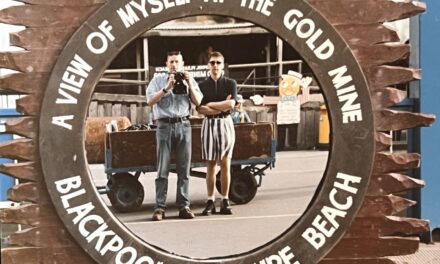Relax. You know the song. And you probably know the band, Frankie Goes to Hollywood. But can you recall who sang lead vocals on the 1984 track?
Top pop points if your answer was Holly Johnson, the musician, artist and influential LGBTQ+ figure. But Johnson’s career consists of more than a handful of hits, some headline news, and 1980s’ stardom. And that’s why he is currently the subject of an exhibition at the Museum of Liverpool.
I take a breath as I enter the exhibition gallery. Museum exhibits that try to tell the story of one person’s life aren’t always a success. Biopic displays tend to suffer from huge bias, revering their subjects as ‘icons’ or ‘legends’ – words which are overused when it comes to biographical tales. By focusing on just one life, they can limit the narrative of an exhibition, excluding others from the story and making it difficult for visitors to find relevance.

© Robin Clewley
Thankfully, this exhibition doesn’t fall into any of the familiar traps. The highly visual display draws visitors into a moment in time in the early 80s – the costume, the photography, the record covers and music videos evoke an era of glamour and celebrity, but also of protest and defiance.
There’s certainly more to this exhibition than an aesthetic. As the narrative moves through chapters of Johnson’s life, the biography is richly illustrated and set in context. We are immersed in the music of the time, a sense of creative freedom, of queer rights struggles, of a period of stifled politics. And within this there’s relevance to lives lived today – of innovation and rebellion, of glamour and celebrity, of loss, fear and stigma around who we are. For as well as being an exhibition about a life, it’s also an exhibition about progress. Johnson lives openly with HIV and continues to be present as an activist, seeking to put a spotlight onto the experiences of others.
But this isn’t an exhibition in which we meet the subject of the biography directly. This is largely a biography of (and commentary on) Johnson’s life, treating him as the subject of the exhibition, rather than placing him as the object in it. Cleverly, it explores much more than one person’s life, threading in stories about all sorts of other people in a delightfully democratising narrative. For visitors, hardened Frankie fans or comparative newcomers, there are multiple ‘ways in’ to this story. The museum’s social history collection has been well deployed in this respect, showing more than just items relating to celebrity and stardom.

Frankie Goes to Hollywood videogame – credit National Museums Liverpool
Sure, there are raunchy black-and-white band photo shoot images and accompanying leather gear. There’s a wall of t-shirts showing Johnson’s influence on progressive politics. Frankie tells us to do more than relax – Frankie calls out Reagan, and Frankie says ‘arm the unemployed’. Perhaps more surprisingly, there’s a copy of the 1985 Frankie Goes to Hollywood videogame for the SX Spectrum, one of the first computer games to feature a pop act, and created locally in offices in Liverpool city centre. In the game, players walk round a fictional town called Mundanesville, trying to win enough points to enter the Pleasuredome.
While that might be a fictional place, there’s a real sense of location in The Holly Johnson Story. The street scenes and club flyers on display are from within walking distance of the museum. The accent and humour certainly place Liverpool at the heart of the space. While I’m visiting, a fan wanders in and gasps at the mention of Big in Japan and Eric’s (more pop fan points if you know these) as audibly and excitedly as a tourist stopping by the Cavern, also not far from here.
With all these hooks, all these moments of social, political and musical relevance, this exhibition could only be right here in Liverpool. And so I am able to put my fears about biographical exhibitions aside, enjoy the ride, and relax.
Main image: © Robin Clewley
The Holly Johnson Story is at the Museum of Liverpool until July 27, 2025. Entry is £5. For more information, click here.








